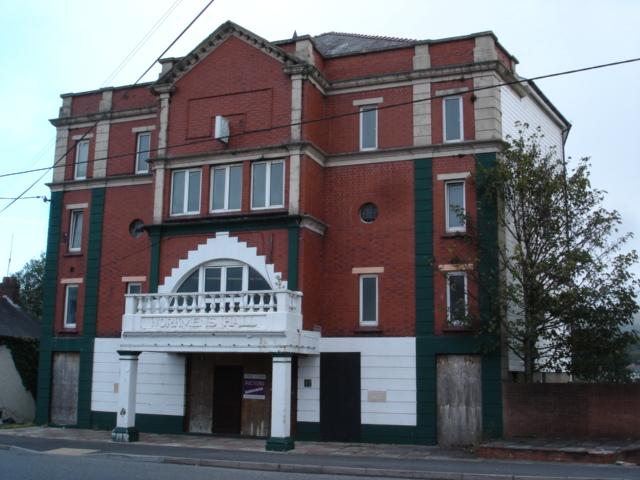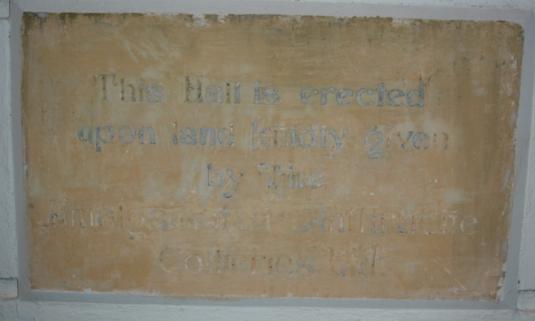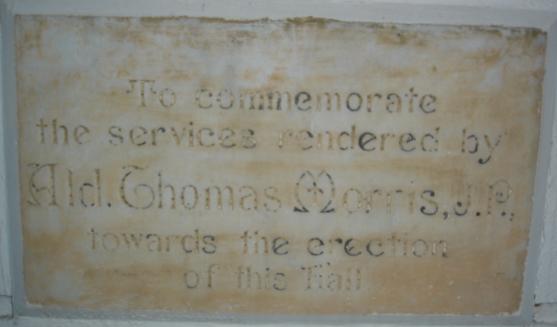Some Captured History of Glanamman and GarnantCwmamman Workmens Hall and InstitutePicture taken Sept 2007 The Cwmamman Workman's Hall and Institute is one of the most prominent buildings in the community and has, since its construction, served as a venue for operas, operettas, concerts and dramas. It has been used as a cinema and more recently, a privately owned leisure centre and club. The old "Hall Y Cwm", as it was commonly known, was built on land owned by the Amalgamated Anthracite Collieries Ltd, who agreed the leasehold on very favourable terms. This company was the owner of the Gellyceidrim Colliery at Glanamman. Two commemorative stones were built into the front wall of the Workmen' Hall. Mr W. J. Williams, of Brynamman, a sculptor, advised the Cwmamman Workmen's Hall Committee to use the best Sicilian Blue Marble with lead letters. These cost £3 each. The wording on the first stone reads as follows: "This
Hall is erected The second stone reads: "To commemorate Alderman Thomas Morris was Chairman of the Cwmamman Workmen's Hall Committee for many years and it was this committee who undertook the challenges associated with organising the building and furnishing of the hall. The committee also had to deal with the financial problems associated with the endeavour. The main bulk of the money came from the contributions made by the workmen of the community; mostly miners and tin plate workers. These had agreed to donate the sum of 6d (Sixpence) per month. A considerable contribution was also received from the Miners Welfare Committee; a body made up from an equal representation of colliery owners and workmen, who made a grant of £3,000 towards the building of the hall. The total cost of the project amounted to a £11,607 7s 7d. The Miners Welfare Committee representative at the time of the construction was Mr. C. S. Mason, who was consulted a great deal. Mr Gilbert H. Davies, who lived almost opposite the hall, was the architect and he was there at all times to be able to advise. He carried out the work free of charge except for payment of office and out of pocket expenses. The legal work regarding the deeds to the property was carried out free of charge by Mr W. Martin Knoyle, who only required payment of the stamp duty. A Clerk of Works was appointed; Mr Tom Davies, of Garnant commenced this duty on 23rd February 1925. The building contractor was Mr. D. J. Thomas, who had once lived at Garnant. On receiving payment for his work, he immediately donated £50 to the Workmen's Hall. Other contractors who carried out work on the hall were David Evans and Son, Brynamman and Mr. T. Bartholomew of Gwaun Cae Gurwen, who carried out the decorating. Mr. James Fuller of Glanamman was responsible for the plumbing work and the steel construction was carried out by the Birchgrove Steel Structural Co. The furnishing of the hall, with its plush blue and red seats, was undertaken by Mr. Harry M. Fuller of Glanamman and Mr. Henson of Ammanford. The County Council gave permission for an electric cable to travel under the road from the Gellyceidrim colliery to the hall. The cost charged by the colliery company being 3d (3 pennies), per unit of electricity. A lady named Dorothy Millward, who lived at Cwmaman House, next door to the hall, recalled her mother, Mrs Lizzie Scourfield, making jugs of tea for the men on the building site. Dorothy would serve the men their tea and for this, she received 1d (1 penny), per week from the men. Cwmaman House was later demolished to make room for a car park at the side of the hall. Initially, it was decided to build a hall capable of seating 1,300 people, but this figure was later revised to 915. The stage, capable of holding a large choir or hosting any play likely to tour the area, measured 55 feet by 30 feet (Approx 18m by 10m). Underneath were 6 dressing rooms and an instrument room. The orchestral stalls contained tip-up plush seats which could be removed to enable the space to be used as a dance floor etc. The ground floor consisted of an entrance hall with pay box, whilst the 1st floor housed a mezzanine floor with refreshments room, managers room, 2 large store rooms and a lounge which gave access to a balcony overlooking the main road at the front of the building. Above, there was a 2nd floor and a gallery. The building also contained heating apparatus, a ventilation system and electric lighting. Committees were formed to make the necessary arrangements for the opening ceremony and evening concert. Responsibility for the opening ceremony was undertaken by the following:
The committee responsible for arranging the evening concert was comprised of the following people:
The opening ceremony commenced at 3pm on 19th February 1927 and this was performed by the Rt. Hon. Thomas Richards, M.P. and the Secretary of the South Wales Miners' Federation. A gold key was handed to the Rt. Hon. Thomas Richards by Mrs D. J. Thomas, wife of the building contractor. The main door was then unlocked and the opening ceremony commenced. When the public had filtered into the building, they were entertained by the Cwmamman Silver Band under the conductorship of Mr Benny Jones. When the curtain was raised the stage contained the following people, most of whom made a speech in turn:
The first speaker was the Chairman, Alderman Tom Morris. He praised the work carried out and told the audience that the first committee had met thirty years previously with the intention of setting up a public hall in Cwmamman and praised the Miners Welfare Committee, without whom it would not have been possible. Mr Finlay Gibson aired his one concern during his address. He pointed out that no provision had been made at the hall for reading and games rooms and was concerned that as it stood, the hall would not be used sufficiently. He asked the committee to consider his suggestion and offered any help that he could give. He also stated that the hall should be for every person in the community and that those at Cwmamman should ensure that this was the case and also to ensure that the committee was elected annually. Other speakers praised the hall and said that it compared favourably against any in London. They also made light in their speeches of the "them and us" attitudes between the mine owners and the miners. Both parties, however, were united in the desire to bring welfare schemes to the miners and the subject of retirement pensions was one of the topics touched upon by the Rt Hon. Thomas Richards M.P. Mr T. H. Henderson, during his speech, donated a wireless and loudspeaker to the hall. This was met with applause. The brief resume of the hall's financial position was given by the secretary, Mr Lewis. He stated that the total of all money in the fund to date amounted to £5,832 17s 1½d, leaving a debt of £6,372 17s 7½d owed to the bank to make up the balance of the total cost of building. After all the speeches had been given, The Rt. Hon. Thomas Richards, Mr John James and Mr Finlay Gibson were each presented with an ebony silver mounted walking stick in appreciation of their services to Welfare work in South Wales. A solo was sung by Mr. Phillip Rees and after the usual notes of thanks were given, the Welsh National Anthem was sung to end the event. The evening concert commenced at 7:30pm. The prices
of admission were 1/- (one shilling) and 6d (half shilling, or 6 pennies).
The artists invited were:
Others taking part were:
Another two soloists requested by the Reception Committee were Madam B. Jones Davies and Mr Stephen Rogerson. A local poet known as Ceidrim (real name, Edwin Rees), read out the penillion in the afternoon. This was probably his own composition. The Workmen's Hall became the main meeting place for the people of Cwmamman and also for others from further afield. The hall committee continued to arrange various forms of entertainment. The well-known and beloved comedian, Ryan Davies, appeared there in his own show before a full house. Sub-committees were formed to take care of the various activities. These included Bookings, Entertainment, Reception, Finance, Building, Eisteddfod and Bingo committees. People were also employed by these committees to carry out the various tasks necessary for the day to day running of the hall. An example would be the skilled operator responsible for running the film shows. He would have also had an apprentice under his care. The stage shows would have required a range of stagehands, each with their own area of responsibility, such as scene changing or lighting for example. The minute books for the Workman's Hall cover a period from 24th December, 1923, to 8th February, 1972, when the hall ceased to function. Mr Ieuan Roberts, a committee member, was elected Treasurer on 18th December, 1967. He was elected Secretary / Manager on 23rd July, 1972 and remained the custodian of the minute books after the closure of the hall. The charitable nature of the hall's committees is evident throughout the minute books. In many deserving cases, the charge for hiring the hall was donated back. This demonstrates the philanthropic qualities of the establishment and people associated with it. Various local societies hired the hall, including the Young Farmers Club, the Urdd, Cwmaman Silver Band, the local branch of the Red Cross Society, the Association for the Blind, the Old Age Pensioners Society, Amman United, the Carnival Committee, Cwmaman Peace Committee, political parties, Trade Unions and various chapels. Other performances to which the hall played host, included the circus: Zip-Zip-Zooray and B.B.C. radio shows, which included Tommy Trouble, We'll Keep a Welcome, Have a Go with Wilfred Pickles and Opportunity Knocks. Concerts included The Festival of Britain and the Cwmamman Coronation Celebrations. Operettas and Operas performed at the venue included:
Some of the notable movies shown at the Workman's Hall were: Song of Freedom (with Paul Robeson), Goodnight Vienna,
Pagliacci, Hound of the Baskervilles, Bulldog Drummond, Sabu, The
Elephant Boy, Hit Parade, Doctor Sin, Jericho, Showboat, Glamorous
Night, Gone with the Wind, The Great Caruso, the Valley of Song, Julius
Ceasar, and The Ten Commandments. Alas, over time, as people's interests changed, the hall ceased to attract the crowds that it once did. The committee tried various ways of making the hall a paying concern; films were shown at first for two or three nights a week, then only once a week. There was a Teen and Twenty club and a Junior Disco club hosted by Mr David Rees and Mrs Vera Jones. Bingo sessions were tried, but despite the efforts of all involved, the venue could not remain viable. The Workman's Hall closed in February, 1972. In December, 1982, after a period of closure, Mr T. Wyn Jones, a local businessman, purchased the hall and initially used it as a builder's supplier. After carrying out a good deal of work to the building, he was able to open the hall as a private leisure centre on 14th December, 1985. This became known as "Canolfan Hamdden Dyffryn Aman", that is, "Amman Valley Leisure Centre" and at one time, this club boasted around 1,000 members. When it ceased to be a leisure centre, the Workmen's Hall became a "Fun Factory", where children were able to safely enjoy a soft play area with slides and climbing frames. Many happy birthday celebrations took place at the venue. Eventually, the hall again closed its doors and has now been idle for some considerable time. It has become a problem for the council and an occasional target for vandalism. There was talk of new owners based in London who intended to convert the building into a number of residential apartments. This did not meet with the approval of the whole of the community, some of whom were concerned that the hall may play host to some undesirable occupants. On the 29th of January 2009, the idle building became
the focus of the local press when the police carried out a drugs raid
and found a substantial number of cannabis plants on the premises.
Hearsay estimated the haul to be worth something near a million pounds.
Since then, the building has remained empty and the fate of the Cwmamman
Workman's Hall remains unknown. The above information was taken from a document
entitled, "The Cwmaman Workmen's Hall and Institute", by
Eynon Jenkins; created c.1996 for the Amman Valley Historical Society.
Eynon Jenkins was allowed access to the Minute Books by their custodian,
Mr Ieuan Roberts. Thanks to Dilys Jenkins for the information and
permission to use her husbands research. Other sources include the
Amman Valley Chronicle. |


